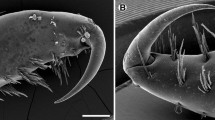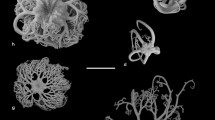Abstract
The morphology of the grooming limbs, the 5th pair of pereiopods, was studied by scanning electron microscopy in six species of porcellanid crabs, Petrolisthes cabrilloi, P. cinctipes, P. armatus, P. galathinus, Pachycheles monilifer, and Pachycheles rudis, and their function was inferred by comparison with findings from previous studies. Grooming limb morphology was almost identical among the four Petrolisthes species and differed little compared to that of the two Pachycheles species. The 5th pereiopods bore a basal tuft of mechanoreceptive setae, three different types of grooming setae armed with setules or denticles, two types of smooth sensilla for location and identification of fouling objects, and a terminal, toothed chela for picking firmly attached objects off the gills and body. The grooming limb was extremely flexible and could reach most parts of the body, including the gill chamber on the opposite side. The grooming limb morphology in Petrolisthes cabrilloi is consistent with its wellknown effectiveness in preventing parasitism by the rhizocephalan Lernaeodiscus porcellanae. Grooming setae remove recently attached cyprids, while the chela can grip and remove the much smaller, firmly attached kentrogons. Porcellanid crabs not known to host rhizocephalans, however, had grooming limbs almost identical to those of Petrolisthes cabrilloi despite their previously demonstrated failure to prevent settlement and infestation by L. porcellanae larvae. The effectiveness of P. cabrilloi in removing kentrogons, therefore, seems also to depend on behavioral adaptations whereby this species recognizes the parasite larvae as high-threat objects.
Similar content being viewed by others
Literature cited
Ache, B. W. (1982). Chemoreception and thermoreception. In: Bliss, D. E. (ed.) The biology of the Crustacea, Vol. 3. Academic Press, London, p. 369–398
Bauer, R. T. (1981). Grooming behaviour and morphology in the decapod crustacea. J. Crustacean Biol. 1: 153–173
Bauer, R. T. (1989): Decapod crustacean grooming: functional morphology, adaptative value, and phylogenetic significance. In: Felgenhauer, B. E., Watling, L., Thistle, A. B. (eds.) Functional morphology of feeding and grooming in Crustacea, Vol. 6 Crustacean issues. A. A. Balkema, Rotterdam, p. 49–73
Brusca, R. C., Brusca, G. (1990). Invertebrates. Sinauer Associates, Sunderland, Massachusetts
Haig, J. (1962). Porcellanid crabs from eastern and western America. Vidensk. Meddr dansk. naturh. Foren. 124: 171–192
Høeg, J. T. (1985). Cypris settlement, kentrogon formation and host invasion in the parasitic barnacle Lernaeodiscus porcellanae (Müller) (Crustacea: Cirripedia: Rhizocephala). Acta. zool., Stockh. 66: 1–45
Pohle, G. (1989). Gill and embryo grooming in lithidid crabs: comparative functional morphology based on Lithodes maja. In: Felgenhauer, B. E., Watling, L., Thistle, A. B. (eds.) Functional morphology of feeding and grooming in Crustacea, Vol. 6. Crustacean issues. A. A. Balkema, Rotterdam, p. 75–94
Ritchie, L. E., Høeg, J. T. (1981). The life history of Lernaeodiscus procellanae (Cirripedia Rhizocephala) and co-evolution with its procellanid host. J. Crustacean Biol 1: 334–347
Schmidt, M., Gnatzy, W. (1984). Are the funnel-canal organs the “campaniform sensilla” of the shore crab, Carcinus maenas (Decapoda, Crustacea)? II. Ultrastructure. Cell Tissue Res. 237: 81–93
Walker, G., Clare, A. S., Rittschof, D., Mensching D. (in press) Aspects of the life cycle of Loxothylacus panopei (Gissler), a sacculinid parasite of the mud crab, Rhithropanopeus harrisii (Gould): A laboratory study. J. exp. mar. Biol. Ecol.
Watling, L. (1989). A classification system for crustacean setae based on the homology concept. In: Felgenhauer, B. E., Watling, L., Thistle, A. B. (eds) Functional morphology of feeding and grooming in Crustacea, Vol. 6. Crustacean issues. A. A. Balkema, Rotterdam, p. 15–26
Author information
Authors and Affiliations
Additional information
Communicated by T. Fenchel, Helsingør
Rights and permissions
About this article
Cite this article
Fleischer, J., Grell, M., Høeg, J.T. et al. Morphology of grooming limbs in species of Petrolisthes and Pachycheles (Crustacea: Decapoda: Anomura: Porcellanidae): a scanning electron microscopy study. Marine Biology 113, 425–435 (1992). https://doi.org/10.1007/BF00349168
Accepted:
Issue Date:
DOI: https://doi.org/10.1007/BF00349168




